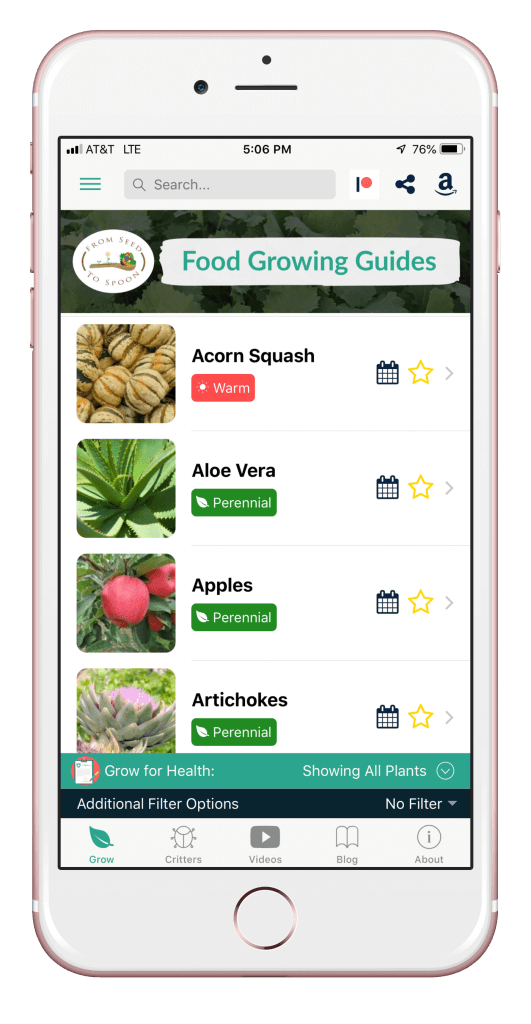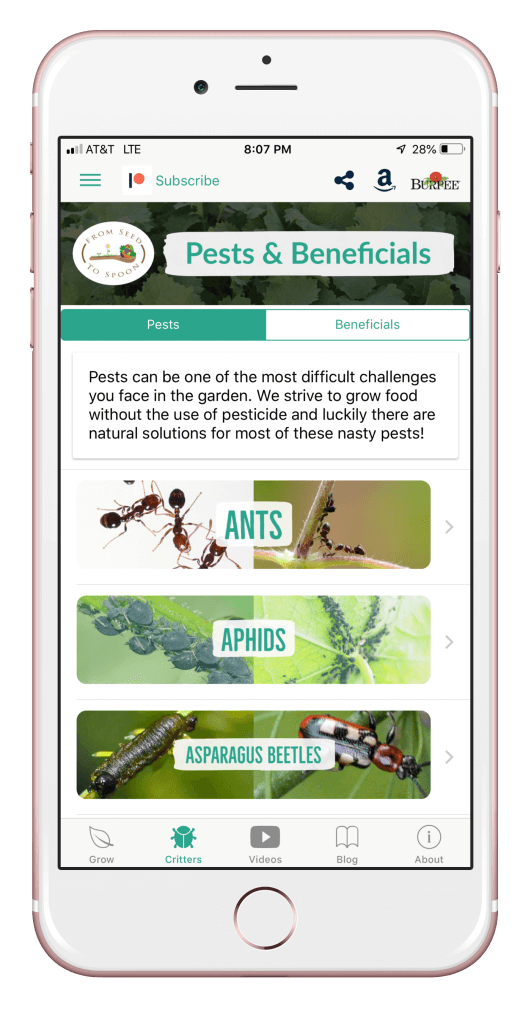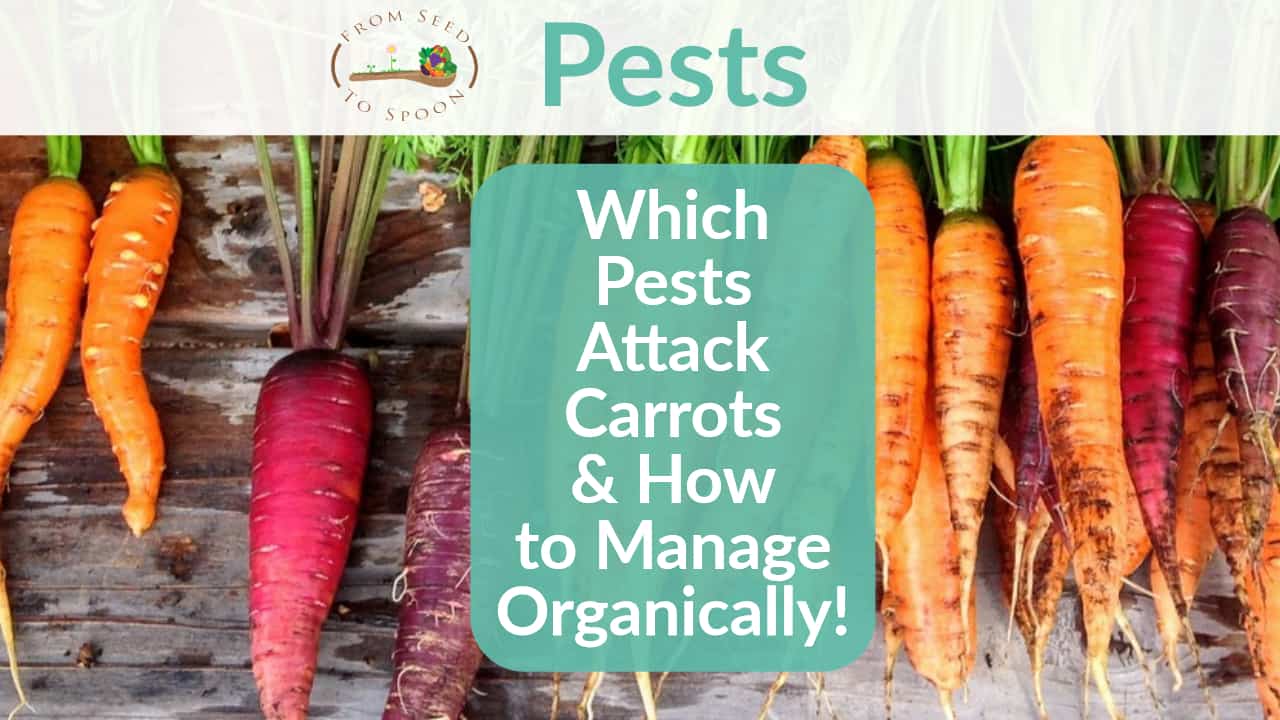Carrots are tough to germinate, but are easy to take care of once they do. We love to grow all different colors and varieties, and the kids have a blast pulling them up! Luckily there are not many pesky pests to deal with for carrots and the ones they do have are fairly easy to manage organically!

The carrot rust fly looks similar to the common house-fly with a dark-green body and yellow extremities and head. The carrot rust fly itself doesn’t do the damage, but their larvae is particularly bad for your plants. The adults lay their eggs early spring on the surface of the soil then the pests hatch a couple days later as creamy white larvae and tunnel into the roots of your plants causing slow growth and sometimes death.
Treatment Options:
- The best treatment is prevention with these flies! The best way to protect against these flies laying their eggs in your garden is to provide a floating row cover.
- Like with most plants, crop rotation is important with the prevention of these flies coming back from year to year and infecting your crop.
- Using a yellow sticky trap can trap these adult flies before they have a chance to lay their eggs. Like with most plants, crop rotation is important with the prevention of these flies coming back from year to year and infecting your crop.

Cutworms are the caterpillar of a brown or gray night-flying moth. The caterpillars are black, gray, or brown and are about an inch and a half long. These jerks can go through your entire garden of new seedlings extremely quickly! It’s important to watch out for them in your garden and do your best to protect again them. They look like little brown worms, and they like to spin around into circles around the plant, cutting it off at the base.
Treatment Options:
- Cover the plants with insect netting (floating row covers) from when they are babies. This will help to prevent them from becoming an issue!
- Cardboard “collars” can be made from toilet rolls or paper towel rolls and placed around each seedling to keep these cutworms out. You can also place toothpicks around seedlings so the worm cannot wrap around the stem.
- Diatomaceous earth can also be laid down around your seedlings to help get rid of them.
- Sprinkling coffee grounds or crumbled egg shells can help repel them from your seedlings as well.

We don’t have to worry about deer here in the city, but those of you in the country know all too well how destructive and challenging deer can be. They can jump over any fence shorter than 8 feet, and there are very few things they won’t eat.
Treatment Options:
- The best thing to do is to build a fence at least 8 feet tall around the garden. There are a few other ideas that you can try, but this is the only guaranteed solution.
- Deer are supposed to be repelled by strong odors. You can place strong scented bar soap in the garden. Another odor you can use to repel them is the human scent. Try placing human hair around the perimeter of your garden.
- Setting up a motion-activated sprinkler can help scare them away as well. Try moving it around so your deer do not start to catch on to your trick!
- There are commercial deer repellents that are available made with all natural ingredients that are supposed to help deter deer from where it is placed.
- Applying blood meal around the perimeter of your garden can also be a help for deterring deer.

These small rodents can create quite a challenge in your garden. They create tunneling systems and eat roots along with shrubs and vegetables.
Treatment Options:
- Cats & dogs are effective hunters of gophers, mice, and other small rodents!
- Flooding the tunnels with water can be effective.
- The gopher hawk is a reusable trap that’s very effective and doesn’t use any chemicals or poisons!
- The Victor Black Box is a reusable trap that’s very effective and doesn’t use any chemicals or poisons!
- You can cover the bottom of your raised bed with hardware mesh to help keep gophers from tunneling into them.
- Solar-powered sonic repellers can also be effective. They create an uncomfortable environment for the gopher by emitting vibrations and sounds into the ground periodically.

These small mammals, called groundhogs or woodchucks, love to eat all the greens in your garden. It is important to keep them out of your garden to protect your food! Repelling woodchucks can be challenging, but there are many natural ways to go about it.
Treatment Options:
- Woodchucks are scared of larger predators. You can buy fox urine granules or animal repellent which helps to repel them. Along this same line, you can also go out and pee in your garden or collect your urine in your house. I know it sounds gross, but it does help to repel them!
- Setting out a small animal trap to catch them is an option.
- Setting up a motion-activated sprinkler can help scare them away.
- Cats and dogs are effective hunters of small rodents! Even just their smell and presence in the yard can help to keep them out of your gardens.

Nematodes, also known as roundworms, can be a microscopic problem living in your soil. They are transparent and unsegmented worms. This blog post will discuss how to manage nematodes in your backyard garden.
Treatment Options:
- The best treatment for nematodes is prevention! Practicing crop rotation from year to year is essential.
- Simply tilling the soil over multiple times throughout the fall and winter months can help to prevent these infestations.
- Adding in new organic matter (compost) when you replant helps to keep nematodes at bay.
- Burn & turn is a term used commonly to get rid of these types of pests in the soil. When your soil is empty of vegetative growth, turn your soil and use a flame thrower to burn the top layer of the soil. If you do not have a flame thrower you can use a dark color plastic sheet to cover over the summer months to heat the temperature of the soil up to a high enough temperature to kill the nematodes.

While we love having our pet rabbit to help with making free fertilizer, wild rabbits can be quite troublesome for your garden. These small mammals like to eat a lot of your greens and can be tricky to manage once they know where the food is. It is important to keep them out of your garden to protect your food!
Treatment Options:
- Placing an automated sprinkler to scare the rabbit away is helpful.
- Rabbits are scared of larger predators. Applying blood meal around the perimeter of your garden has been shown to deter rabbits. Rabbit repellent, fox urine granules, or even human hair and urine can help to deter them as well.
- You can also use a live animal cage trap to catch them.

There are many species of root maggots. Root maggots come from dark green-black fly that look like small houseflies. These flies lay their eggs in the roots of your plants. These maggots are very small, yellow-white larvae with pointed heads. They feed upon the roots causing stunted growth, deformities, and could lead to death of the plant. Treatment can vary depending upon the type of fly that lays their eggs, but there are many organic ways to control all of these root maggots.
Treatment Options:
- Creating a “collar” for the plant made from a toilet roll or paper towel roll can be beneficial as well to help keep the fly away from the base of the plant.
- Sprinkle diatomaceous earth over areas you want to protect. Be careful though: DE can harm beneficial insects as well if they come in contact with it.
- Cover the plants with insect netting (floating row covers) from when they are babies. This will help to prevent them from becoming an issue!
- Yellow sticky traps can also work to catch these flies so they cannot lay their eggs to become maggots.

Thrips are tiny straw-colored insects with two pairs of wings. They can damage plants by sucking out their juices causing discoloration and even death!
Treatment Options:
- As with most pests, the best solution is prevention. Placing a floating row cover with insect netting will help to prevent these critters from eating your plants
- Another good prevention is to remove excess weeds and grass around the garden areas as this can help to attract them.
- Placing blue sticky traps around your garden can help to catch these thrips and alert to a possible issue.
- You can use neem oil as well to help control thrips. Make sure to not apply the neem oil though when the temperature is above 90, or else you could suffocate your plant!
- There are also several beneficial insects that can help you in the garden with these pests too! Minute pirate bugs, ladybugs, and lacewings can help to keep your thrips away.

These small rodents can be challenging and can destroy a garden! Voles (Field Mice) are usually first spotted by their ~3-inch holes they make in raised beds. Once you see these, it’s time to get into action before they get out of hand. Voles multiply quickly and will wreak havoc on not only your garden, but also your garden supplies like tarps, sheeting, and other materials. They can be pesky, so trial and error is important to see what works best for your visitors.
Treatment Options:
- We’ve found a great treatment for mice and voles is to have a house full of dogs and cats. They do a great job in helping to keep them under control. In case you do not have a cat or dog that enjoys to hunt down mice, there are a few options for taking care of this problem yourself.
- Out of everything, we’ve found the tried and true mouse trap to be the most effective solution. We really like the plastic and metal traps found on Amazon. Simply put a little peanut butter or dog food on the trap and set it out near active spots. There are also electric ones that make it things much easier!
- There are ultrasonic pest repellers that you can place in the ground that send vibrations out to scare the mice away and out of your garden.
- Stationing a fake owl around the garden can also be helpful to scare away field mice. Be sure to move the owl around, or they might figure out your trick!

These soil-dwelling pests, also known in their adult form as click beetles, attacks the plants soon after germination. It is important to treat for wireworms before it gets out of hand.
Treatment Options:
- The best way to prevent issues it to practice good crop rotation. Make sure to not plant vegetables of the same family in the same place each season. This should prevent them from becoming an issue.
- Tilling your soil each year will help to disrupt the breeding of these pests.
- Beneficial nematodes can also be purchased to help control wireworms.
Learn more about growing over 100 different foods, including how to manage various pests in our FREE iOS, Android, or Universal Web App!



Carrie Spoonemore, co-founder of “From Seed to Spoon,” stands as a beacon of inspiration for gardeners and health enthusiasts alike. Her journey alongside her husband, Dale Spoonemore, in creating a platform that demystifies gardening and promotes a healthier lifestyle, has made a significant impact on individuals around the globe. Through the “From Seed to Spoon” app, Carrie has dedicated herself to empowering people to take control of their health and environment by growing their own food.
With a profound belief in the power of gardening to improve mental and physical health, Carrie’s contributions to the Seed to Spoon blog reflect her holistic approach to wellness. Her articles often focus on the nutritional benefits of homegrown fruits and vegetables, organic gardening practices, and the mental health benefits of spending time in nature. Carrie’s expertise in health science shines through in her detailed discussions on how specific plants can contribute to a balanced diet and overall well-being.
Carrie’s passion for gardening is deeply intertwined with her commitment to family and community wellness. She frequently shares personal stories of how gardening has brought her family closer together, offering practical tips for involving children in gardening activities and making it a fun, educational experience. Her writing encourages families to explore gardening as a means of spending quality time together while learning about nature and sustainability.
In addition to gardening advice, Carrie’s contributions to the blog include insights into the use of technology to enhance the gardening experience. She has played a crucial role in designing the “From Seed to Spoon” app to be user-friendly, ensuring that users of all ages and backgrounds can navigate the complexities of gardening with ease. Her vision for the app is not just as a gardening tool but as a vehicle for change, inspiring individuals to adopt a more sustainable lifestyle by growing their own food.
Carrie Spoonemore’s presence on the blog is marked by her compassionate approach to teaching and her unwavering belief in the transformative power of gardening. Her work continues to inspire a community of gardeners to pursue a healthier, more sustainable way of living, proving that with the right tools and knowledge, anyone can become a gardener and advocate for their health and the planet.








One thought on “How to Manage the Most Common Pests for Carrots Organically in Your Backyard Vegetable Garden”
As much as I hate carrots, I must grow them because everyone else likes them. Yuck! I am fortunate (or unfortunate) that they have almost no problems here. I am able to keep the wildlife away from them.